Big Ideas Math Integrated Math Chapter 2 Maintaining Mathematical Proficiency
Page 27 Exercise 1 Problem 1
Question 1.
Graph the absolute value of the given number:
|-2|
Answer:
We have to graph the number ∣−2∣
Given a number, ∣−2∣
The absolute value is 2.
Therefore, ∣−2∣ = 2

The graph of ∣−2∣ is

Page 27 Exercise 2 Problem 2
Question 2.
Graph the result of the following expression:
-3 + |-3|
Answer:
We have to graph the number −3 + ∣−3∣
Given, −3 + ∣−3∣
The absolute value of −3 is 3
So, −3+∣−3∣ = −3+3
= 0

The graph of −3+∣−3∣ is

Page 27 Exercise 3 Problem 3
Question 3.
Determine whether -4 is greater than or less than -7.
Answer:
We have to decide −4 is greater or lesser than − 7
Is greater than−7.
−4 lies right side of−7, so
−4 is greater than−7.

So − 4 > − 7
The desired solution for this is − 4 > − 7
Page 27 Exercise 4 Problem 4
Question 4.
Determine whether -8 is greater than or less than -5.
Answer:
Now we have to decide −8 is greater or lesser than − 5.
−8 is lesser than −5
−8 lies left side of −5, so −8 is less than −5

So − 8 < − 5
The desired solution of this is − 8 < − 5
Page 27 Exercise 5 Problem 5
Question 5.
Determine whether |-5| is greater than, less than, or equal to 5.
Answer:
Given
|-5|
Now we have to decide ∣−5∣ is greater or lesser than or equal to 5.
As we know in number in modulus treated as positive number .
So here number 5 is equal to 5 Or ∣−5∣ = 5
The desired solution of this is ∣−5∣ = 5.
Page 27 Exercise 6 Problem 6
Question 6.
Determine whether -7 is greater than, less than, or equal to |-6|.
Answer:
Given
-7
Now we have decided −7 is greater or lesser or equal to ∣−6∣.
As we know any number in modulus treated as positive number.
So here ∣−6∣ is treated as + 6.
So As we know
−7 < ∣−6∣
The desired solution of this is −7 < ∣−6∣.
Page 27 Exercise 7 Problem 7
Question 7.
Using a number line, represent the numbers a, b, -a, and -b.
Answer:
Given
The numbers a, b, -a, and -b.
First, we have to make a number line representing a,b,−a,−b.
After that move on basis that has been described in Tips section.
Now we have to represent numbers a,b,−a,−b.

As we know number present right-hand side of any number are greater then number presented left-hand side are smaller.
So here is a greater than b and −b is greater than −a.
−b is greater than−a.
Page 27 Exercise 8 Problem 8
Question 8.
Using a number line, represent the numbers a, b, -a, and -b. Additionally, represent the absolute values |-a| and |-b|.
Answer:
Given
a, b, -a, and -b.
First, we have to make a number line.
After that represent a,b,∣−a∣,∣−b∣
Now we have to represent a,b,−a,−b on number line.

So here − b < − a.
As we know any number in modulus treated as a positive number.

So here by the number line representation ∣−b∣ is greater than ∣−a∣
The desired solution is ∣−b∣ is greater than ∣−a∣.
Page 28 Exercise 9 Problem 9
Question 9.
Determine the type of inequality and present it graphically.
Answer:
We first find the type of inequality.
In this question greater than equal to type inequality available.

In the above diagram point is cover and goes to infinity so it is greater than equal to type inequality. or we can say x≥1

The desired solution is x ≥ 1.
Page 28 Exercise 9 Problem 10
Question 10.
Determine the type of inequality and write the equation of the inequality based on the given graph.
Answer:

First, we find the type of inequality.
Then write the equation of inequality.

It is greater than type inequality in word x > 1
The Desired solution is x > 1
Page 28 Exercise 9 Problem 11
Question 11.
Determine the type of inequality and write the equation of the inequality based on the given graph.
Answer:
For the given graph.
The inequality equation is x ≤ 1
In words are x is less than or equal to 1
The inequality equation is x≤1, In words are “x is less than or equal to 1”
Page 28 Exercise 9 Problem 12
Question 12.
Determine the type of inequality and write the equation of the inequality based on the given graph.
Answer:
For the given graph.
The inequality equation is x<1
In words are x is less than 1
The inequality equation is x<1 , In words are “x is less than 1”
Page 29 Exercise 10 Problem 13
Question 13.
Describe how mathematical inequalities are used in everyday situations. Provide examples of situations where inequalities are applied and explain how they represent real-life constraints.
Answer:
Inequalities are used all the time in the world around us—we just have to know where to look.
Figuring out how to interpret the language of inequalities is an important step toward learning how to solve them in everyday contexts.
Think about the following situations.
Speed limits on the highway minimum payments on credit card bills the number of text messages you can send each month.
From your cell phone the amount of time it will take to get from home to school.
All of these can be represented as mathematical inequalities.
These situations on a day-to-day basis are confronted with mathematical inequalities but we may not notice them because they are so familiar.
Page 31 Exercise 11 Problem 14
Question 14.
Translate the following sentence into a mathematical inequality:
“Seven is less than or equal to the difference of a number q and 6.”
Answer:
The sentence as an inequality is.
Seven is less than or equal to the difference of a number q and 6.
Hence the equation as inequality is
⇒ 7 ≤ q− 6
Hence the equation as inequality is 7≤ q − 6
Page 31 Exercise 12 Problem 15
Question 15.
Translate the following sentence into a mathematical inequality:
“The sum of a number u and 14 is more than 6.”
Answer:
The sentence is an inequality.
The sum of a numbers u and 14 is more than 6.
Hence The equation inequality is
u + 14 > 6
The equation as inequality is u + 14 > 6
Page 31 Exercise 13 Problem 16
Question 16.
Graph the linear inequality x ≥ 3.
Answer:
Given
x ≥ 3
To graph, a linear inequality in one variable (say, x or y ), first get variables alone on one side.
Then consider the related equation obtained by changing the inequality sign to an equality sign.
The graph of this equation is a line.
Here the equation is x ≥ 3
Then the graph is

where dot represent the x = 3
The graph of the equation is

Page 32 Exercise 14 Problem 17
Question 17.
Graph the linear inequality x > -1.
Answer:
Given
x > -1
To graph, a linear inequality in one variable (say, x or y ), first get variables alone on one side.
Then consider the related equation obtained by changing the inequality sign to an equality sign. The graph of this equation is a line.
Here the equation is x > −1
Then the graph is

where circle represent x ≠ − 1
The graph of the equation is

Page 32 Exercise 15 Problem 18
Question 18.
Graph the linear inequality x < 1 and describe the characteristics of the graph.
Answer:
Given
x < 1

x<1 is made dark as shown in above graph
We write values below or above 1
we write whether 1 is included in graph
We write about circle on1
We write values included in graph
x<1 is made darker in the above graph.
We can see 0,−1,−2 below 1
1 is not included in graph,it is open.
Circle on 1 is not filled
We can see 0,−1,−2 that is lesser values included in graph
The graph for x<1 is as shown in graph
Where we see 1 is not included.
Values less than 1 are included in the graph

Page 32 Exercise 16 Problem 19
Question 19.
Observe the given graph and determine the inequality it represents. Describe your observations and the steps to determine the inequality.
Answer:
We write observations looking at graph such as whether 1 is included or not.
We write about circle on 1
We then write about values included in the graph are above or below 1
We arrive at decision whether we use less than or greater than or equal to sign
Then we write inequality as per our observation
we can see 1 is not included in the figure so it is open. Circle on 1 is not filled.
We see values above 1 like 2,3,….. etc.
This means inequality in the graph is x>1
1 is not included so it is open in the graph.
The graph shows values above 1.
Hence the inequality that represents the graph is x>1
Page 32 Exercise 17 Problem 20
Question 20.
Observe the given graph and determine the inequality it represents. Describe your observations and the steps to determine the inequality.
Answer:
We write observations looking at graph whether 0 is included or not.
We write about circles on 0.
We then write about values included in the graph are above or below 0.
We arrive at decision of whether we use less than or greater than or equal to sign.
Then we write inequality as per our observation
We can see 0 is not included in the figure so it is open circle on 0 is not filled.
We see values below 0 like −1,−2,……etc.
This means inequality in the graph is x<0
0 is not included in the graph so it is open.
The graph shows values below 0.
Hence the inequality that represents the graph is x<0
Page 32 Exercise 18 Problem 21
Question 21.
Observe the given graph and determine the inequality it represents. Describe your observations and the steps to determine the inequality.
Answer:
We write observations looking at graph whether −3 is included or not.
We write about circle on −3.
We then write about values included in graph e are above or below −3.
We arrive at decision whether we use less than or greater than or equal to sign.
Then we write inequality as per our observation
−3 is included in the graph circle on −3 is filled so we use equal to sign in inequality of graph.
We see values above −3 like −1,−2,……. etc.
This means inequality in the graph is x≥−3
−3 is included in the graph.
The graph shows values above −3.
Hence the inequality that represents the graph is x ≥ −3
Page 32 Exercise 19 Problem 22
Question 22.
Observe the given graph and determine the inequality it represents. Describe your observations and the steps to determine the inequality.
Answer:
We write observations looking at graph whether 3 is included or not.
We write about circle on 3
We then write about values included in the graph are above or below 3
We arrive at decision of whether we use less than or greater than or equal to sign.
Then we write inequality as per our observation
3 is included in the graph circle on 3 is filled so we use equal to sign in the inequality of graph.
We see values below 3 like 1,2,…. etc.
This means inequality in the graph is x≤3
3 is included in the graph.
The graph shows values below 3.
Hence the inequality that represents the graph is x ≤ 3.
Page 33 Exercise 20 Problem 23
Question 23.
Solve the following inequalities using addition and subtraction. Show all steps clearly.
- Solve inequality x – 3 < 5 using addition.
- Solve inequality x + 5 > 10 using subtraction.
Answer:
We write an example as solving x−3 < 5 for addition.
We add 3 to each side of above inequality.
Thus adding 3 solves inequality.
Now we write an example as solving x+5>10 we subtract 5 from each side of inequality.
Thus subtracting 5 solves inequality.
Hence we use addition and subtraction to solve inequality
We solve inequality by using addition.
For example x − 3 < 5.
We add 3 to each side of above inequality
x − 3 + 3 < 5 + 3
x < 8
We solve inequality using subtraction.
For example x + 5 > 10
Subtracting 5 from both sides of above inequality.
x + 5 − 5 > 10 − 5
x > 5
We add 5to both sides of x − 3 < 5 Solving we get x < 8 We subtract 5 from both sides of x + 5 > 10 Solving we get x > 5
Page 34 Exercise 21 Problem 24
Question 24.
Given the passing efficiency formula: \(P=\frac{8.4 Y+100 C+330 T-200 N}{A}\)
Determine a set of values for A, C, Y, T, and N that make the inequality P < 0 true. Verify the solution by substituting the values into the formula and showing that the inequality holds.
Answer:
Given : P<0
To find – A passing record that makes the inequality true.
First of all we will assume the values of different variables.
Then we will check for these values so that the given inequality is satisfies.
Passing efficiency formula is P=\(\frac{8.4 Y+100 C+330 T-200 N}{A}\)
Let’s consider
A = 240
C = 130
Y = 1200
T = 14 and
N = 150
⇒ P\( = \frac{8.4(1200)+100(130)+330(14)-200(150)}{240}\)
⇒ P = \(\frac{10080+13000+4620-30000}{240}\)
⇒ P = \(\frac{27700-30000}{240}\)
⇒ P = \(\frac{−2300}{240}\)
⇒ P = − 9. 58
⇒ P < 0
Let’s fill the table now.

The final answer is that the passing record that makes the given inequality true is A = 240, C = 130, Y = 1200, T = 14, and N = 150
Page 34 Exercise 21 Problem 25
Question 25.
Given the inequality:
P + 100 ≥ 250
and passing efficiency formula: \(P=\frac{8.4 Y+100 C+330 T-200 N}{A}\)
Determine a set of values for A, C, Y, T, and N that make the inequality true. Verify the solution by substituting the values into the formula and checking the inequality.
Answer:
Given: P + 100 ≥ 250
To find – A passing record that makes the inequality true.
First of all we will assume the values of different variables.
Then we will check for this values so that the given inequality satisfies.
Passing efficiency formula is P = \(\frac{8.4 Y+100 C+330 T-200 N}{A}\)
Let’s consider
A = 300
C = 210
Y = 2500
T = 25 and
N = 8.
⇒ P = \(\frac{8.4(2500)+100(210)+330(25)-200(8)}{300}\)
⇒ P = \(\frac{21000+21000+8250-1600}{300}\)
⇒ P = \(\frac{48650}{300}\)
⇒ P = 162.16
⇒ P + 100 = 262.16
⇒ P + 100 > or < 250.
Let’s fill the table now.

The final answer is that the passing record that makes the given inequality true is A = 300, C = 210, Y = 2500, T =25, and N = 8.
Page 34 Exercise 21 Problem 26
Question 26.
Given the inequality:
P – 250 > -80
and passing efficiency formula: \(P=\frac{8.4 Y+100 C+330 T-200 N}{A}\)
Determine a set of values for A, C, Y, T, and N that make the inequality true. Verify the solution by substituting the values into the formula and checking the inequality.
Answer:
Given: P−250>−80
To find – A passing record that makes the inequality true.
First of all we will assume the values of different variables.
Then we will check for these values so that the given inequality satisfies.
Passing efficiency formula is P = \(\frac{8.4 Y+100 C+330 T-200 N}{A}\)
Let’s consider
A = 250
C = 180
Y = 3000
T = 25 and
N = 6.
⇒ P \(=\frac{8.4(3000)+100(180)+330(25)-200(6)}{250}\)
⇒ P = \(\frac{25200+18000+8250-1200}{250}\)
⇒ P = \(\frac{50250}{250}\)
⇒ P = 201
⇒ P − 250 = 201 − 250
⇒ P − 250 = − 49
⇒ P − 25 0 > − 80
Let’s fill the table now.

The final answer is that the passing record that makes the given inequality true is A = 250, C = 180, Y = 3000, T = 25, and N =6.
Page 34 Exercise 22 Problem 27
Question 27.
Explain how to use addition and subtraction to solve inequalities. Provide examples to illustrate each method.
Answer:
Let’s first understand the use of addition to solve an inequality by taking an example.
If x − 2 ≤ 5 is an inequality.
Adding 2 to both sides, we get
x − 2 + 2 ≤ 5 + 2
⇒ x ≤ 7
which is the solution of the given inequality.
We will now understand the use of subtraction to solve an inequality by taking an example.
If x + 7 > 5 is an inequality.
Subtracting 7 from both sides, we get
x + 7 − 7 > 5 − 7
⇒ x> − 2
which is the solution of the given inequality.
The final answer is that we can use addition or subtraction such that only the variable term remains on either side of the inequality and then it will be easy to solve an inequality.
Page 36 Exercise 23 Problem 28
Question 28.
Given the inequality -3 > -3 + h:
- Solve the inequality by adding 3 to both sides and simplify.
- Represent the solution on a number line.
Answer:
Given: Inequality is − 3 > − 3 + h.
Add 3 on both side of the inequality and simplify it.
Now represent the inequality on a number line.
We have
− 3 > − 3 + h
⇒ − 3 + 3 > − 3 + h + 3 (Adding3 both side)
⇒ 0 > h
⇒ h < 0
Representing the inequality on a number line.

The solution of the inequality −3 > − 3 + h is h<0 and its representation on number line is given below.

Page 37 Exercise 24 Problem 29
Question 29.
Given the inequality s-(-1)≥2:
- Simplify the inequality.
- Subtract 1 from both sides of the inequality and simplify further.
- Represent the solution on a number line.
Answer:
Given: Inequality is−(−1)≥2.
Simplify it and then subtract 1.
On both side of an inequality.
Now represent the inequality on a number line.
We have
s − (−1) ≥ 2
⇒ s + 1 ≥ 2
⇒ s + 1− 1 ≥ 2 − 1 (Subtracting 1 on both side)
⇒ s ≥1
Representing the inequality on a number line.

The solution of the inequality −(−1) ≥ 2 is s ≥ 1 and its representation on the number line is given below.

Page 37 Exercise 25 Problem 30
Question 30.
Given the inequality 6 – 9 + u < -2:
- Simplify the inequality.
- Add 3 to both sides of the inequality and simplify further.
- Represent the solution on a number line.
Answer:
Given: Inequality is6−9+u<−2.
Simplify it and then add 3 both side of an inequality.Now represent the inequality on number line.
We have
6 − 9 + u < − 2
⇒ −3 + u < − 2
⇒ −3 + u + 3 <− 2 + 3 (Adding 3 both side)
⇒ u < 1
Representing the inequality on a number line.

The solution of the inequality 6−9 + u <− 2 is u < 1 and its representation on number line is given below.

Page 38 Exercise 26 Problem 31
Question 31.
Complete the table and determine whether the inequality 6<3x is true or false for each given value of x. Then, solve the inequality by dividing both sides by 3 and choose the correct solution from the given graph.
Answer:
Complete the table and decide whether the inequality 6 < 3x is true or false for each case.
Divide by 3 on both sides of the inequality 6 < 3x and find the solution.
Now choose the correct solution from the given graph.

We have
6 < 3x
⇒ \(\frac{6}{3}\) < \(\frac{3x}{3}\)
⇒ 2 < x
⇒ x > 2
The correct solution from the given graph is

The solution of the inequality is x >2 and its representation on number line is given below.

Page 38 Exercise 27 Problem 32
Question 32.
Complete the table and analyze it to find the solution for each of the given inequalities. Then, write the solution for each inequality and represent it on a number line.
Answer:
Given:
Inequalities are:
⇒ 1.2 x < 4
⇒ 2.3 ≥ 3x
⇒ 3.2x < 8
⇒ 4.6 ≥ 3x
Complete the table and analyze it to find the solution of given inequality.
We have 2 x < 4

Therefore the solution is x < 2
The rule is divide the coefficient of x both sides of the equality.
Therefore the solution is x < 2
We have 3 ≥ 3x
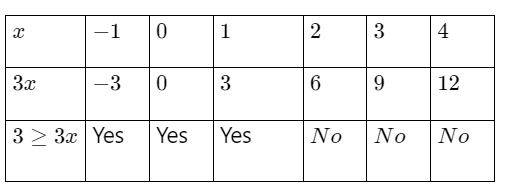
We have 2 x < 8

We have
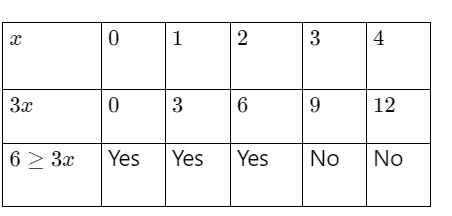
All are represented in tables.
Page 39 Exercise 28 Problem 33
Question 33.
- Consider the effects of dividing both sides of an inequality by positive and negative numbers.
- Given the inequality 3<4, divide both 2 and determine whether the inequality sign changes or remains the same.
- Given the inequality 3<4, divide both sides by -2 and determine whether the inequality sign changes or remains the same.
- Explain the rules for dividing inequalities by positive and negative numbers.
Answer:
Lets consider the inequality.
3 < 4
⇒ \(\frac{3}{2}\)<\(\frac{4}{2}\) (Dividing both side by 2)
⇒ 1.5<2 (Sign of inequality remains same)
Again consider the inequality.
3 < 4
⇒ \(\frac{3}{−2}\)<\(\frac{4}{−2}\)
(Dividing both side by−2)
⇒ −1.5 > −2 (Sign of inequality changes)
If we divide by a positive number on both sides of inequality the sign of inequality remains the same.
If we divide by a negative number on both side of inequality the sign of inequality changes.
Page 39 Exercise 30 Problem 35
Question 35.
Solve the inequality 7x < -21 using the rule for dividing both sides of the inequality by the coefficient of the variable. Then represent the solution on a number line.
Answer:
Given
7x < -21
We have to solve each inequality 7x < − 21
From Page 38 Exercise 27 Problem 32, Tables we get- Part 1 a rule that is
To find the solution of the inequality we have to divide both sides of the inequality by the coefficient of the variable.
From Page 38 Exercise 27 Problem 32, Tables we get – Part 1
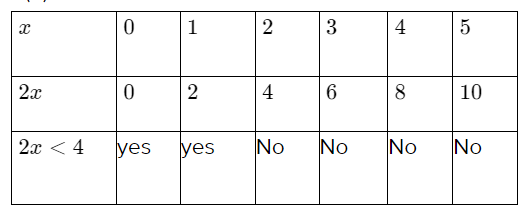
The solution of the inequality is x < 2

The solution of the inequality is 1 ≥ x

The solution of the inequality is x < 4

The solution of the inequality is 2 ≥ x
The rule is to divide both sides of the inequality by the coefficient of x.
Given, 7x < − 21 divided by 7 on both sides of an inequality.
x<− \(\frac{21}{7}\)
x < − 3

The solution is x < − 3

Page 39 Exercise 30 Problem 36
Question 36.
Solve the inequality 12 ≤ 4x using the rule for dividing both sides by the coefficient of the variable. Then represent the solution on a number line.
Answer:
We have to solve each inequality 12 ≤ 4x
From Page 38 Exercise 27 Problem 32, Tables we get Part 1 a rule to find the solution of the inequality.
The rule is to get the solution of the inequality we have to divide both sides of the equality by the coefficient of the variable.
If the coefficient of x is negative then the inequality sign will be inverted.
Here the coefficient of x is 4.
From Page 38 Exercise 27 Problem 32, Tables we get – Part 1
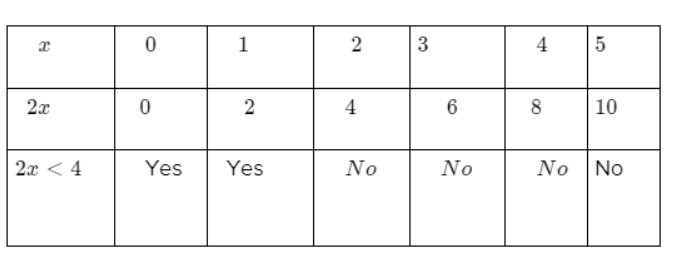
The solution of the inequality is x < 2
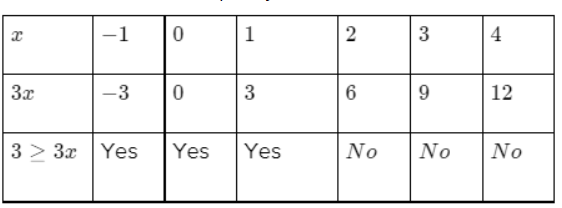
The solution of the inequality is 1 ≥ x
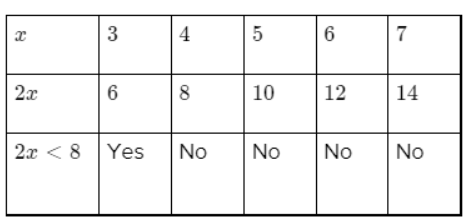
The solution of the inequality is x < 4
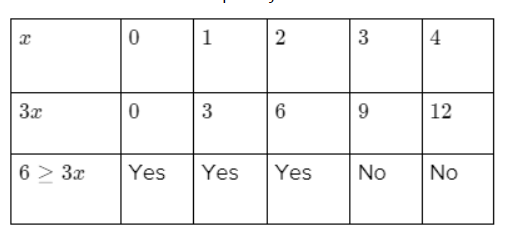
From Page 38 Exercise 27 Problem 32, Tables we get – Part 2
The solution of the inequality is x ≤ 2

The solution of the inequality is x >− 2
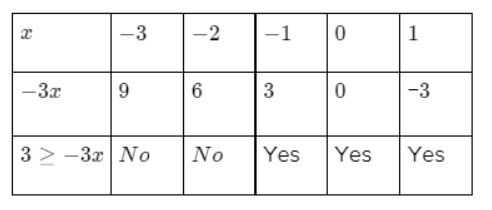
The solution of the inequality is −1 ≤ x
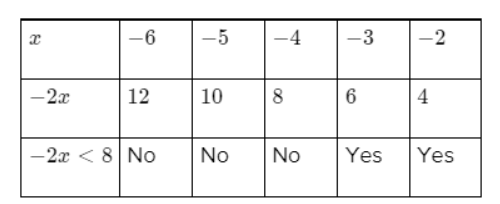
The solution of the inequality is x > − 4
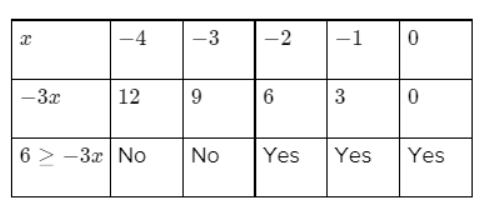
The solution of the inequality is x ≥ − 2
We conclude that:
The rules of solution a inequality are
Divide the both sides by the coefficient of x
If the coefficient of x is a negative number then invert the inequality sign
Given,12 ≤ 4x
4x ≥ 12
Divide by 4 on both sides of an inequality.
x ≥ \(\frac{12}{4}\)
x ≥ 3


The solution is x ≥ 3
Page 39 Exercise 30 Problem 37
Question 37.
Solve the inequality 10 < -5x using the division rule of inequality. Show all steps clearly.
Answer:
We are given an inequality 10 <−5x.
We need to use the division rule of inequality to solve it.
We are going to apply the division rule of inequality on given inequality.
And then solve it until we get the variable on one side and the number on the other.
10<−5x
⇔ \(\frac{10}{−5}\)>\(\frac{−5x}{−5}\)
(∵if x<y and z<0 then \(\frac{x}{z}\) >\(\frac{y}{z}\))
⇔ − 2 > x
By using the division rule of inequality for 10<−5x, we get −2 > x.
Page 39 Exercise 30 Problem 38
Question 38.
Solve the inequality -3 x ≤ 0 using the division rule of inequality. Show all steps clearly and represent the solution on a number line.
Answer:
We are given an inequality −3 x ≤ 0
We need to use the division rule of inequality to solve it.
We are going to apply the division rule of inequality on given inequality.
And then solve it until we get the variable on one side and the number on the other.
From we get Page 38 Exercise 27 Problem 32 (Part 1 and Part 2)
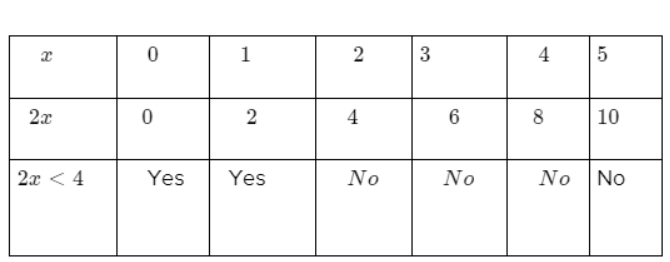
The solution of the inequality is x < 2

The solution of the inequality is x ≤ 1
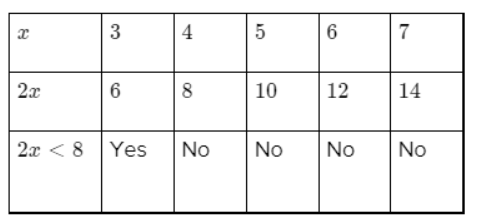
The solution of the inequality is x < 4
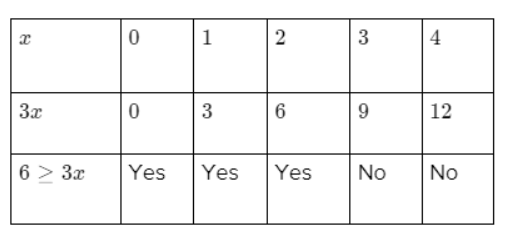
The solution of the inequality is x ≥ − 2

The solution of the inequality is x > − 2
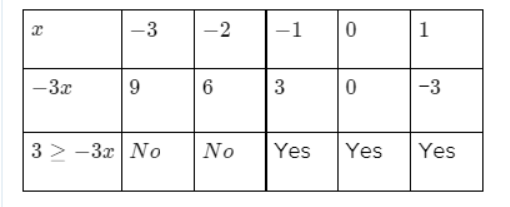
The solution of the inequality is x ≥ − 1
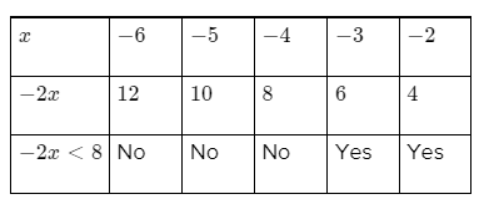
The solution of the inequality is x > − 4
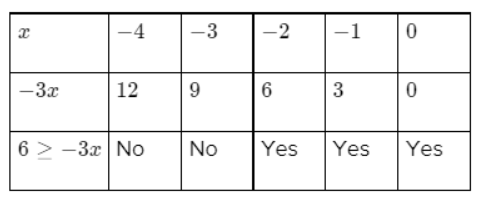
The solution of the inequality is x ≥ − 2
The rules are:
Divide both sides of the inequality by the coefficient of x.
If the coefficient of x is a negative number then invert the inequality sign.
Find the interval of inequality using division rule
−3x < 0
⇔ \(\frac{−3x}{−3}\) > \(\frac{0}{−3}\)
(∵if x<y and z<0 then \(\frac{x}{z}\) >\(\frac{y}{z}\))
⇔ x > 0

By using the division rule of inequality for −3x ≤ 0 we get x ≥ 0.

Page 41 Exercise 31 Problem 39
Question 39.
Solve the inequality -67 ≤ 37f using the multiplication property of inequality. Then, represent the solution on a number line.
Answer:
We are given an inequality \(\frac{−6}{7}\) ≤ \(\frac{3}{7}\) f
We have to solve it and graph the solution.
We will do this by using the multiplication property of inequality.
To obtain the required solution, we will solve till we get the variable on one side and numbers on another side.
Finally, we will represent this solution on a number line.
On the number line, fill in the circle for (≤or≥) and leave the circle unfilled for (<or>).
\(\frac{−6}{7}\)≤\(\frac{3}{7}\) f
⇔ \(\frac{−6}{7}\) ×\(\frac{7}{3}\)
(∵If x≤y, and z>0,then xz≤yz)
⇔ \(\frac{3}{7}\)f×\(\frac{7}{3}\)
⇔ 2 ≤ f
For inequality \(\frac{−6}{7}\)≤\(\frac{3}{7}\) f
Interval notation of solution: (−2,∞)
The representation of solution on the number line:

The required solution to the inequality\(\frac{−6}{7}\)≤\(\frac{3}{7}\) f is −2 ≤ f . Graph of solution

Page 41 Exercise 32 Problem 40
Question 40.
Solve the inequality -4m ≥ -16 using the division property of inequality. Then, represent the solution on a number line.
Answer:
We are given an inequality −4m≥−16
We have to solve it and graph the solution.
We will do this by using the division property of inequality.
To obtain the required solution, we will solve till we get the variable on one side and number on another side.
Finally, we will represent the solution on a number line.
On the number line, fill in the circle for (≤or≥) and leave the circle unfilled for (<or>)
−4m ≥−16
⇔ \(\frac{−4m}{4}\) ≤ \(\frac{−16}{−4}\)
(∵If x≥y and z<0, then \(\frac{x}{z}\) ≤ \(\frac{y}{z}\))
⇔ m≤4
For inequality −4m≥−16
Interval notation of solution: (−∞,4)
The representation of solution on the number line:

The required solution to inequality −4m≥−16 is m≤4. Graph of solution

Page 42 Exercise 33 Problem 41
Question 41.
Solve the inequality \(1 \leq-\frac{1}{4} y\) using the multiplication property of inequality. Then, represent the solution on a number line.
Answer:
We are given an inequality 1≤−\(\frac{−1}{4}\) y
We have to solve it and graph the solution.
We will do this by using the multiplication property of inequality.
To obtain the required solution, we will solve till we get the variable on one side and number on another side.
Finally, we will represent the solution on a number line.
On the number line, fill in the circle for (≤or≥)and leave the circle unfilled for (<or>).
1≤−\(\frac{−1}{4}\) y
⇔ 1×−4≥−\(\frac{−1}{4}\) y × −4
(∵ If x≤y and z<0, then xz≥yz)
⇔ −4 ≥ y
For inequality 1≤−\(\frac{−1}{4}\) y
Interval notation of solution: (−∞,−4)
The representation of solution on the number line:

The required solution to inequality 1≤−\(\frac{−1}{4}\) y is −4 ≥ y. Graph of solution

Page 42 Exercise 34 Problem 42
Question 42.
Solve the inequality \(-\frac{2}{3}<-4 x\) using the division property and the multiplication property of inequality. Then, represent the solution on a number line.
Answer:
We are given an inequality \(\frac{−2}{3}\)<− 4x
We have to solve it and graph the solution.
We will do this by using the division property and the multiplication property of inequality.
To obtain the required solution, we will solve until we get the variable on one side and the number on another side.
Finally, we will represent this solution on a number line.On the number line, fill in the circle for (≤or≥) and leave the circle unfilled for (<or>).
−\(\frac{−2}{3}\) <−4x
⇔ −\(\frac{−2}{3}\)<−4x × 3<−4x × 3
(∵ If x<y and z>0,then xz<yz)
⇔ −2<−12x
⇔ −\(\frac{−2}{12}\) > \(\frac{−12}{−12}\) x
(∵ If x < y and z<0, then \(\frac{x}{z}\)>\(\frac{y}{z}\))
⇔ \(\frac{1}{6}\)> x
For inequality \(\frac{−2}{3}\) <−4x
Interval notation of solution: (−∞,\(\frac{1}{6}\))
The representation of solution on the number line:

The required solution to inequality <−4x is \(\frac{−2}{3}\) \(\frac{1}{6}\) >x. Graph of solution:

